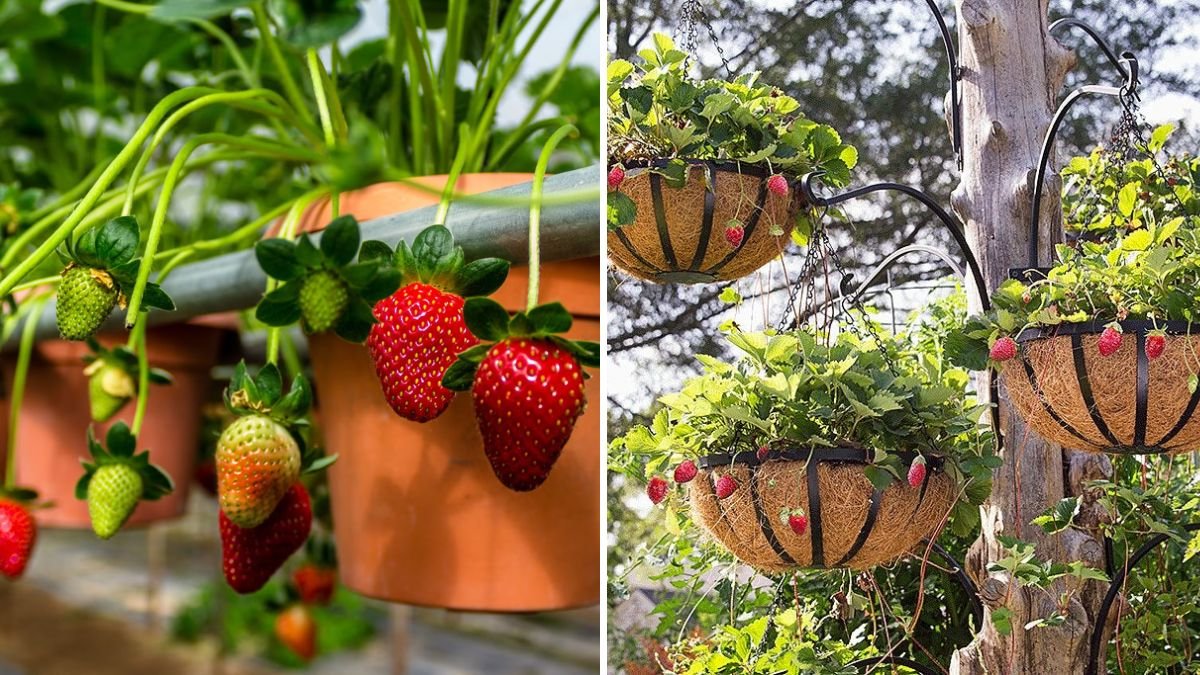Strawberries are not only delicious but also visually appealing, making them an ideal choice for container gardening on balconies, patios, and terraces. Growing strawberries in hanging containers maximizes space, adds a decorative element to your outdoor area, and allows for easy maintenance and harvesting. However, success depends on proper container choice, soil preparation, planting techniques, and care practices.
This article provides a comprehensive guide on how to grow strawberries in hanging containers, ensuring healthy plants and abundant fruit throughout the growing season.
1. Why Choose Hanging Containers for Strawberries
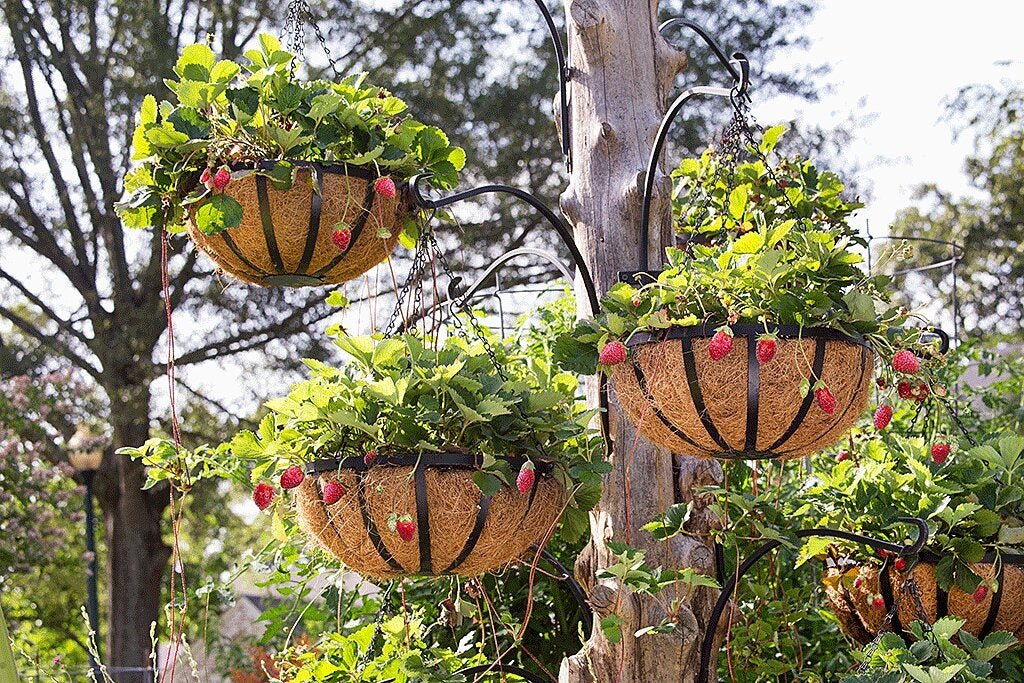
Hanging containers offer several advantages for strawberry cultivation:
- Space Efficiency: Ideal for small balconies or urban gardens.
- Improved Air Circulation: Reduces the risk of fungal diseases like powdery mildew and gray mold.
- Pest Management: Keeps fruits off the ground, minimizing exposure to slugs, snails, and insects.
- Aesthetic Appeal: Cascading strawberries create a visually appealing garden feature.
Hanging containers allow gardeners to grow strawberries even in areas with limited ground space, while providing easy access for care and harvest.
2. Selecting the Right Strawberry Variety
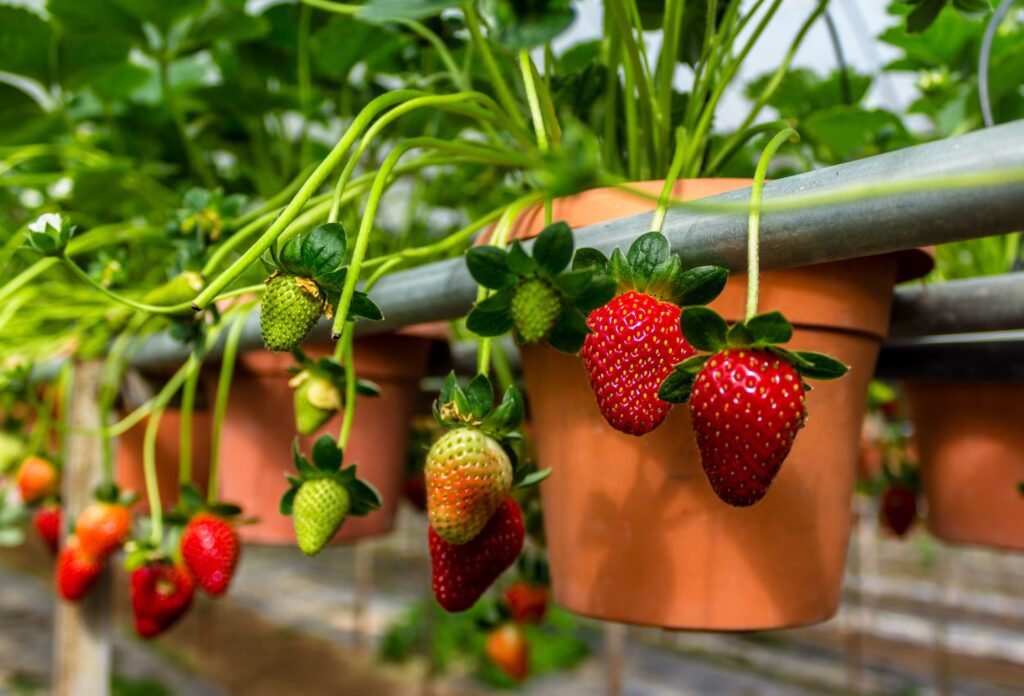
The choice of strawberry variety significantly affects growth and yield in hanging containers:
- June-Bearing Varieties: Produce a large harvest over a few weeks, ideal for maximum summer yield. Examples: ‘Earliglow,’ ‘Allstar.’
- Everbearing Varieties: Produce two to three harvests per season, providing continuous fruit. Examples: ‘Ozark Beauty,’ ‘Seascape.’
- Day-Neutral Varieties: Yield strawberries throughout the growing season, regardless of day length. Examples: ‘Albion,’ ‘Tristar.’
For container growth, everbearing or day-neutral varieties are preferred due to their consistent fruiting and manageable plant size.
3. Choosing the Right Hanging Container
Proper container selection is critical for strawberry health:
- Size: Minimum 10–12 inches in diameter and depth to support root development.
- Material: Plastic, ceramic, or resin pots; lightweight containers are easier to hang.
- Drainage: Ensure multiple drainage holes to prevent waterlogging and root rot.
- Shape: Basket-style or tiered hanging pots allow trailing runners to cascade naturally.
A well-chosen container promotes healthy roots, adequate drainage, and optimal fruit production.
4. Preparing the Soil Mix
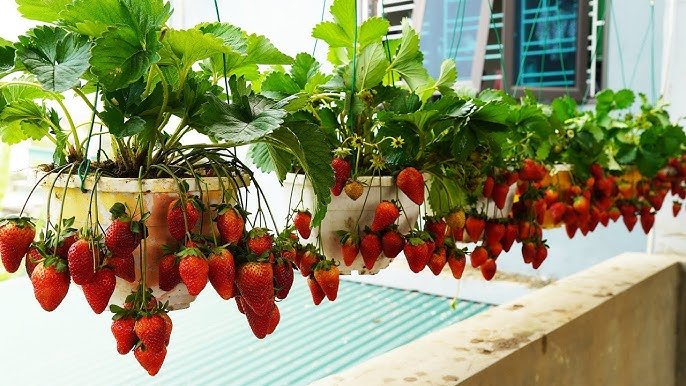
Strawberries thrive in fertile, well-draining soil:
- Components:
- 40% high-quality potting mix
- 30% organic compost
- 20% coco peat or peat moss for moisture retention
- 10% perlite or sand for drainage
- Soil pH: Slightly acidic, ideally 5.5–6.5.
- Moisture Retention: The soil should be light yet retain enough moisture to prevent stress.
- Fertilization: Mix in slow-release fertilizer at planting for a nutrient boost.
Well-prepared soil ensures strong root systems, healthy foliage, and abundant fruiting.
5. Planting Strawberries in Hanging Containers
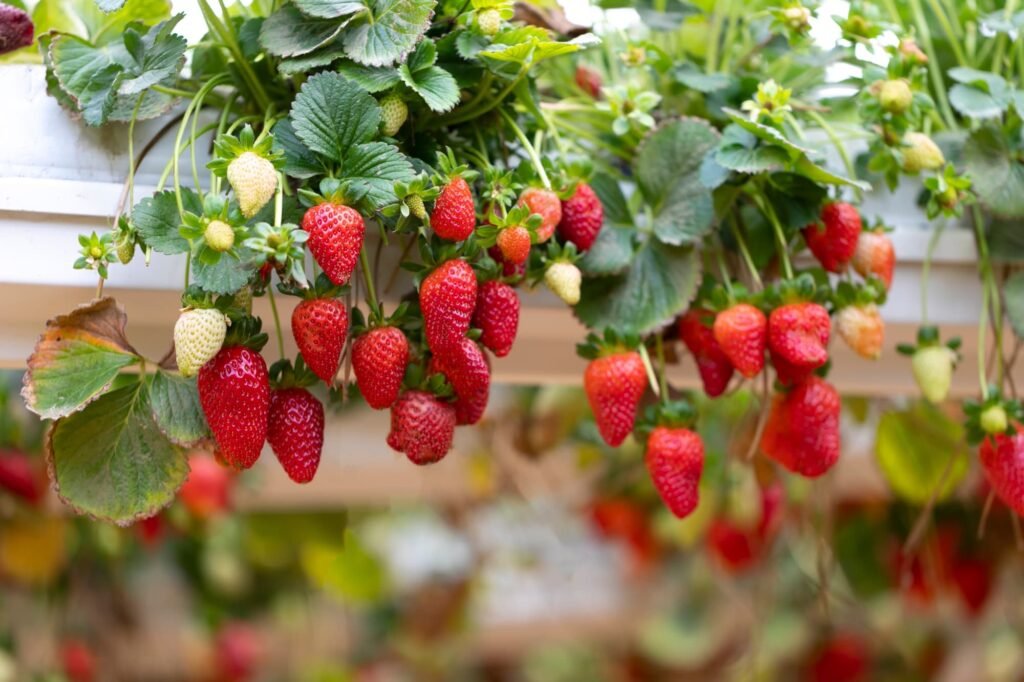
Proper planting technique is essential for healthy growth:
- Fill Container: Fill hanging pot with prepared soil, leaving 2 inches from the rim.
- Planting Depth: Ensure crowns are at soil level; planting too deep or too shallow can harm growth.
- Spacing: Plant 3–4 strawberries per 12-inch container to allow space for runners.
- Watering After Planting: Gently water to settle soil around roots without causing compaction.
Correct planting ensures healthy establishment and reduces transplant shock.
6. Positioning for Sunlight
Strawberries require full sunlight for maximum fruiting:
- Daily Requirement: 6–8 hours of direct sunlight.
- Placement: Hang containers where plants receive morning or midday sun.
- Rotation: Rotate containers periodically to ensure even sunlight distribution.
- Partial Shade: Protect from scorching afternoon sun in very hot climates to prevent leaf burn.
Adequate sunlight enhances flowering, fruit development, and flavor.
7. Watering Practices for Hanging Containers
Consistent watering is crucial for strawberries:
- Frequency: Water every 2–3 days in hot weather, adjusting for rainfall.
- Method: Water directly at the soil level, avoiding wetting leaves or fruit to reduce fungal risk.
- Soil Moisture: Keep soil evenly moist but not soggy.
- Self-Watering Containers: Consider using containers with reservoirs to maintain consistent moisture.
Proper watering ensures healthy leaves, robust fruiting, and prevents stress-related diseases.
8. Fertilization for Abundant Fruit
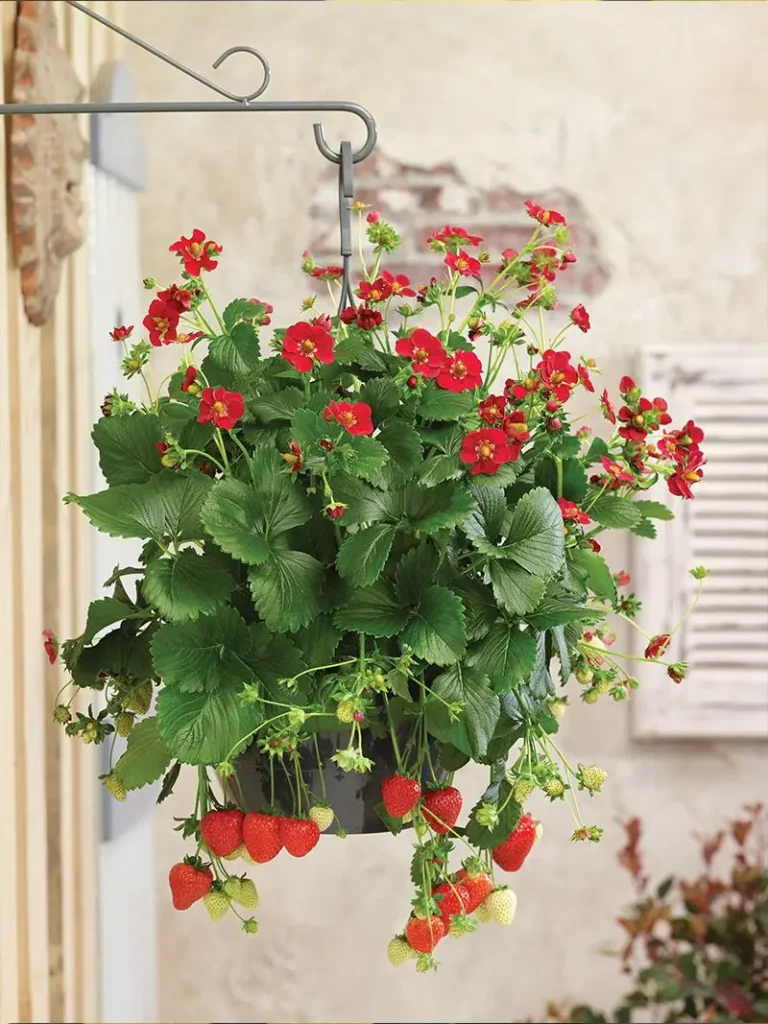
Container strawberries need regular nutrients for sustained growth and fruit production:
- Organic Fertilizers: Compost tea, fish emulsion, or worm castings.
- Liquid Fertilizers: Balanced NPK (10-10-10) every 2–3 weeks during the growing season.
- Avoid Over-Fertilization: Excess nitrogen promotes foliage growth but reduces fruiting.
- Foliar Feeding: Spray micronutrients like magnesium or calcium for strong fruit development.
Fertilization ensures juicy, flavorful strawberries with consistent yields.
9. Managing Runners
Strawberries naturally produce runners, which can affect container growth:
- Containment: Trim runners if containers are small to focus energy on fruiting.
- Propagation: Rooted runners can be planted in separate containers for expansion.
- Encouraging Fruit Production: Excess runners should be removed during flowering to prevent nutrient diversion.
Proper runner management maximizes fruit yield and maintains container plant health.
10. Pest and Disease Control
Even in containers, strawberries are susceptible to pests and diseases:
- Common Pests: Aphids, spider mites, slugs, and birds.
- Prevention: Keep containers clean, remove dead leaves, and avoid overcrowding.
- Organic Control: Neem oil, insecticidal soap, or netting for birds.
- Fungal Diseases: Powdery mildew or gray mold can be prevented with good air circulation and watering at soil level.
Effective pest and disease management ensures healthy plants and unblemished fruit.
11. Seasonal Care and Maintenance
Seasonal adjustments optimize growth and fruiting:
- Spring: Plant new strawberries and fertilize established plants.
- Summer: Monitor watering, mulch soil to retain moisture, and remove runners.
- Autumn: Reduce fertilizer slightly; trim old leaves and prepare for cooler weather.
- Winter: In mild climates, protect containers from frost; in colder regions, bring pots indoors or insulate.
Seasonal care ensures year-round productivity and plant survival.
12. Harvesting Strawberries from Hanging Containers
Timely and careful harvesting is key:
- Maturity: Harvest when berries are fully red and firm.
- Frequency: Pick every 2–3 days during peak season to encourage continuous production.
- Technique: Gently twist or cut fruit, avoiding damage to stems and leaves.
- Storage: Use fresh immediately or refrigerate for short-term storage.
Proper harvesting ensures maximum yield, fruit quality, and plant longevity.
13. Design and Aesthetic Tips
Hanging strawberries not only produce fruit but also enhance visual appeal:
- Trailing Display: Allow runners to cascade naturally for a lush look.
- Container Colors: Choose vibrant pots to complement red strawberries.
- Mixed Planting: Combine strawberries with herbs like thyme or trailing flowers like petunias for ornamental value.
- Arrangement: Layer multiple hanging pots at varying heights for a striking balcony display.
Design considerations make strawberry containers both functional and decorative.
Conclusion
Growing strawberries in hanging containers is an efficient and rewarding way to cultivate fresh fruit in small spaces. By selecting suitable varieties, using proper containers and soil mixes, providing adequate sunlight, watering, and nutrients, gardeners can enjoy healthy plants and abundant fruit. Managing runners, preventing pests and diseases, and implementing seasonal adjustments further enhance plant growth and yield.
With thoughtful care, hanging strawberry containers can transform a balcony into a vibrant, productive, and visually appealing garden, demonstrating that urban gardening can provide both beauty and nutrition, even in limited spaces.
